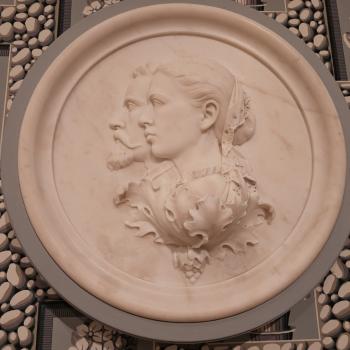 In eastern Turkey about eight miles northeast of the city of Shanli-Urfa ( aka ancient Edessa) is a high place. The Bible has a lot to say about high places, and Gobeckli Tepe (which means pot-bellied hill) is one of them. On a clear day, like the day I was there, you can see a hundred miles in most any direction from the top of Gobeckli. Here are two pictures to give you a sense of the elevation of this place.
In eastern Turkey about eight miles northeast of the city of Shanli-Urfa ( aka ancient Edessa) is a high place. The Bible has a lot to say about high places, and Gobeckli Tepe (which means pot-bellied hill) is one of them. On a clear day, like the day I was there, you can see a hundred miles in most any direction from the top of Gobeckli. Here are two pictures to give you a sense of the elevation of this place. 
High places were and are places the ancients (and moderns) go to get in touch with one god or another. They are traditional sites where sacrifices are offered (see e.g. the story of Abraham and Isaac, or see the high place on the top of the tel at Megiddo within the city walls).
Gobeckli Tepe is indeed one of those places. What makes it stand out from places like Megiddo is that there is no archaeological evidence at all of any residences around the 20 or so stone circles on top of this hill. It is a specific site set up for a specific purpose. We can certainly debate what the purpose or purposes were, but there is no debate that it is a site dedicated to something specific. Among the theories that has been noised about, but has less credence, is that this is some sort of menagerie or zoo. I’m not buying it. Are we really to imagine the ancients, (busy trying to survive their day to day existence and living a subsistence life full of hard work), had time and interest to set up a zoo? Hardly. This is nearly as plausible as imagining we have here the holding pens for Noah’s critters before they were inserted into the ark. This then would truly be a arkeology site, were that the case.
There is now available an impressive and detailed monograph about the site written by the lead archaeologist, Klaus Schmidt. It’s title is Sie bauten die ersten Tempel. Das ratselhafte Heiligtum der Steinzeitjager (C.H. Beck, 2006-07). No my friends, I am afraid this important work is not in English yet. C’est la vie. To do scholarly work on the Bible you need at least three modern languages (never mind the ancient ones)— German, French, and English. This book chronicles carefully the some seventeen years of meticulous and careful work of Schmidt and his team, co-ordinating finds here and from near by sites like Nevali Cori. Schmidt is by no means done. Only four of the circles have been dug up, and this summer they plan to cover them with a metal roof for protection. At this rate it will take another 50 or so years to finish this excavation. Schmidt knew almost immediately he was on to something big when he set foot on the site, and he realized if he put his hand to the trowel here, he would spend the rest of his life here. Alla jacta est. He did it, and is doing it. Such is the life of a dedicated archaeologist. He lives in nearby Urfa and commutes back and forth to the site which is quite literally in the middle of nowhere— or more specifically in the middle of farm country. It was a Turkish farmer who first saw something like this—
 It was sticking up in his field. The earliest guess in the sixties was that this was a Byzantine tel with Byzantine ruins. Those guesses could not have been more wrong. What we have here is the oldest religious complex in the world. And guess where it is? It’s between the rivers of the Tigris and Euphrates mentioned in the story of the Garden of Eden. It is just down the road from the apex of the fertile crescent in Haran where Abraham stopped on the way to the promised land. It is, in short in the very place many have long thought human civilization began, and perhaps even human life began. It is interesting that the current issue of Christianity Today has an article chronicling how the latest debate in the evolution discussions is whether there was in fact an original pair of humans from which all other humans come—- can you say Adam and Eve? I knew you could. Regardless of where that argument goes, Gobeckli will stretch our categories in many ways, for example, we have here a serious and severe challenge to young earthers.
It was sticking up in his field. The earliest guess in the sixties was that this was a Byzantine tel with Byzantine ruins. Those guesses could not have been more wrong. What we have here is the oldest religious complex in the world. And guess where it is? It’s between the rivers of the Tigris and Euphrates mentioned in the story of the Garden of Eden. It is just down the road from the apex of the fertile crescent in Haran where Abraham stopped on the way to the promised land. It is, in short in the very place many have long thought human civilization began, and perhaps even human life began. It is interesting that the current issue of Christianity Today has an article chronicling how the latest debate in the evolution discussions is whether there was in fact an original pair of humans from which all other humans come—- can you say Adam and Eve? I knew you could. Regardless of where that argument goes, Gobeckli will stretch our categories in many ways, for example, we have here a serious and severe challenge to young earthers.
About young earth theory I have several points to make in passing as I don’t want to get off subject: 1) the dating of Gobeckli to 9,800 B.C. appears to be correct (more on this in a later post). This makes it enormously older than the stone monoliths at Stonehenge or on Easter Island, and thousands of years older than the pyramids as well and according to young earthers it would be older than the earth itself! Which of course is impossible. We have to rearrange the way we think about when actual civilization and religion per se began on earth. Most anthropologists have suggest a date around 10,000 for the beginning of human civilization. Gobeckli will almost certainly cause a recalculation on that. 2) the Bible tells us absolutely nothing about the age of the earth anyway. The genealogies in the OT are segments, selective, and in some cases are royal genealogies which leave out names and indeed whole generations of names. You can’t even judge the age of human civilization from the Bible, never mind the age of the earth; 3) I especially do not believe God purposely intended to give fossils and other aspects of the earth ‘the appearance of age’ without it really being that old. This is deception plain and simple, and God is not a deceiver. Period. Exclamation point; 4) the Bible is not a scientific textbook written in a pre-scientific era, and often we ask the wrong questions of it. It’s concerns are with history and theology and ethics. Not with geology and the like. We need to stop reading the Bible anachronistically, reading our own modern urgencies back into these sacred texts. Having got that off my chest, we must turn to the second post.












